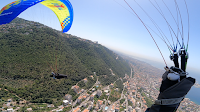The new C for 2021 from MacPara has arrived. Having flown both earlier versions, I was excited to test fly their latest release.
Shark nose, The Elan 3 is manufactured using the excellent lightweight materials from Porcher Sport. Skytex 38, Skytex 32 and Skytex 27.
The lines are made from Edelrid, Aramid Kevlar for the upper lines, PPSL lines for the lower lines.
The construction and details are superb. The risers have a connection between the B and the C for efficient C steering.
Launching the Elan 3 at 93 all up is smooth and easy. The Elan 3 rises effortlessly without any hard point even in nil wind. If the Delta 4 is sometimes slow to launch, the Elan 3 like the Allegro is easier to inflate.
Flying with my X-rated 6 at 93,94 all up, the Elan 3 seems fast at trim. Similar to a Bonanza 2 in trim speed and 1-2 km/h faster at top speed.
I flew the Elan 3 in different conditions, from a strong day in the Cedars spot at 3000 ASL to the lower spots with warm air and inversions at 800 ASL. In all conditions, the Elan 3 felt homogenous without any parasital movements whatsoever. The Elan 3 is very different from the Elan 1 and the Elan 2 in terms of overall feel. While being comfortable to fly for a C, and a very successful DHV rating, with one C, the Elan 3 DNA flies and feels different. The feel under it is like a super easy and comfortable baby Magus.
The pitch when entering thermals is incredibly efficient without any pitch back at all. A slight pitch forward that pulls you efficiently into the core. The Elan 3 needs a slightly more active pilot control than the Elan 2, Delta 4, but still easy to manage for a C, while giving the pilot an educated but comfortable feedback of the class above without the demanding piloting control a D glider gives.
To explain more, I could say that for pilots who find that flying a Delta 4 or Elan 2 is too dampened in overall feel, the Elan 3 will offer the little extra spice that an educated pilot will cherish for the same comfort, or possibly a 10% more pilot control.
In turbulent and strong air, the structure felt very solid and very homogenous.
The brake pressure is on the moderate side. I could control the Elan 3 in a moderate 15 - 25 cm of brakes after the first 10 cm of a gap. It resembles the Alpina 4 brake length with slightly more pressure.
The agility of the Elan 3 is very slightly less than the Elan 2, but I was very satisfied with its efficiency.
The Elan 3 has precise brake travel, and I could say that it has more direct control than a Supair Savage, with slightly more agile. Not as agile as an Alpina 4 for example that could core the thermals really tight, but the Elan 3 is not that far, with a much more performance-oriented turning ability.
Flying the Elan 3, I was able to core every thermal without missing any. The turns are flat without a dive.
Flying the Elan 3 in moving air showed me the bigger difference, as the Elan 3 has the ability to surf efficiently the moving air mass, and to convert every moving air into the lift. That’s why I wrote above that the feel under it is very different. The Elan 3 was surfing the lift lines and moving forward and upward like the class above!
Doing some glides in calm air showed me the Elan 3 shares the best glide for today's C, at trim, and at full bar. It is in moving air that the Elan 3 will be more efficient through the airmass.
Climbing in weak and strong conditions seems also efficient. The Elan 3 has an amazing ability to convert any movement to lift, and that’s exactly its strong point. Even in sudden and strong cores, I could turn precisely the Elan 3 into the stronger core.
 Ears are stable, reopen faster with little help. Induced asymmetries kept the Elan 3 on the path and very easy to recover.
Ears are stable, reopen faster with little help. Induced asymmetries kept the Elan 3 on the path and very easy to recover.
Conclusion:
That kind of feel and handling suits my personal flying style a lot. It reminded me of the Trango X-race handling, but slightly mellower in turns and of course tamer in turbulence.
Mac Para has lifted the Elan series to a new dimension and feel. If you have never flown a Mac Para, now is the time to taste that special feel under the Elan 3 ! It is so different from the too dampened older series, but still quite comfortable with that specially added spice. The difference between the old and the new one is that the Elan 3 will cut through the airmass more efficiently and resembles the upper ratings in that matter!
The C steering is a bit hard to pull but efficient to keep the Elan 3 overhead in turbulence.
The Elan 3 movements and overall comfort in turbulence target exactly the C category pilots. I think a pilot downgrading from a higher-rated glider won’t lose that special feel under the D gliders while getting the passive safety of the C category.
A good B pilot with two full seasons in strong conditions will find the Elan 3 as one of the best logical evolution for the solid C category.































